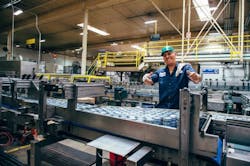Manufacturers Require Transparency, Accountability from OEMs
As manufacturers respond to new competitive and consumer demands, they are relying on OEMs to take on more responsibility, as well.
Bumble Bee Seafoods, for example, recently finished a capacity expansion at its Santa Fe Springs, Calif., plant, which included replacing all of the retorts (where canned products are sterilized), adding new filling capabilities and rebuilding one complete packaging line. During this process, which began in 2015, the company enlisted the help of several new and existing OEM suppliers. It was an eye-opening experience as it relates to communication, collaboration and accountability, according to Jan Tharp, the executive vice president and COO at Bumble Bee.
Bumble Bee, like many consumer packaged goods companies (CPGs), is looking to machine builders for strategic partners. And the key to any great relationship is communication and understanding. In this case, that means considering the personality of the factory. “I look at factories like they are people, each with its own different skillsets and quirks,” Tharp explains.
To that end, OEMs need more information and visibility into production schedules, constraints, changeover frequency and the overarching expectations of the production lines to gain insight into the factory’s culture and infrastructure. But all of this sharing goes both ways, as OEMs have to provide transparency as well.
For example, in the Santa Fe Springs project, there was one piece of equipment where the Bumble Bee engineers specified a requirement for six packaging variations at various speeds as part of the main criteria. Once delivered, the machine met the criteria for five variations, but completely missed the mark on the sixth. “So that variation had to go back to the drawing board, which doesn’t help us when our expectations were that all variations would meet the criteria,” Tharp says. “We feel, in this case, we were used as the R&D arm of this OEM as they tried different solutions to address the issue. We didn’t sign up for that.”
Although the overall project was successful, looking back on the OEM that missed the mark, Tharp wonders had they brought all of the constituents—including internal engineers, OEMs and key production staff—into a room together to talk about the expectations before the RFP was executed, maybe they could have avoided the extra work.
“If everyone was on the same page with what we were ultimately trying to accomplish, we could have had dialogues ahead of time that could have prevented standing in front of the machine with the red light flashing due to an equipment malfunction,” she says.
Tharp is adamant that OEMs need to be honest about a machine’s capabilities upfront. And, she acknowledges that end users need to provide insight into the inner workings of their operation, including functional and safety priorities, as well as how machines need to integrate with other systems.
As Tharp points out, communication is key. But it also might be a primary obstacle in cases such as this. Perhaps it’s not so much an honesty issue, but more of a language barrier—which is where organizations like PMMI, The Association for Packaging and Processing Technologies, can help. PMMI’s OpX Leadership Network is working on an RFP template that ensures end users and OEMs are speaking the same language when it comes to the bidding process.
Data decisions
Of course, to have informed conversations, you need information. In a recent interview with National University, Tharp discussed how Bumble Bee analyzes every aspect of the supply chain from the time the fish comes out of the ocean to the time it gets to the store shelf. In addition, she tells Automation World that the company analyzes downtime data in the plant to reduce waste, improve efficiencies and seek opportunities for better preventive maintenance.
But what’s missing in the factory setting, she says, is an enterprise view that looks at the entire production facility and applies predictive analytics to what should happen if there is an issue in a specific area of the plant. This view should also provide data with respect to machine maintenance, and early predictors as to when a machine needs service or adjustments. Today, if equipment goes down, the company relies on an extremely tenured workforce and their institutional knowledge to resolve issues. But if system-wide data were collected, coupling past experiences and machine knowledge with the current plant dynamics, it would allow the organization to make proactive decisions rather than react to equipment failures. It would also decrease the reliance on institutional knowledge, and speed up the learning curve for new employees.
Machine builders could help in that respect—especially if they were granted remote access to the plant. It’s a good concept, but there are hurdles to clear from a security standpoint. Given the right trusted partners, however, Tharp would welcome the help of OEMs located beyond the Bumble Bee walls.
“It can be frustrating when we have the need for a service technician and the person we need with a specific skill set is somewhere else on another job at least one flight away. So, either we need to wait or someone else is sent who sometimes is seeing the equipment for the first time,” Tharp says. “Giving the OEM the ability to [remotely] see what’s going on would be beneficial. The challenge for us is allowing that connectivity without compromising security.”
With the right OEM and the right conversations, it’s a future possibility, Tharp says. “If you are looking to improve anything, it boils down to effective communication. It is the key to improving any relationship," she says. "As technology continues to change at a rapid pace, our vehicles and methods of communication will also need to change."
About the Author
Stephanie Neil
Editor-in-Chief, OEM Magazine

Leaders relevant to this article:
